In modern times, the design and layout of a basketball stadium lighting system typically start with creating a flexible grid using specialized lighting design software. This initial step is crucial, as it allows the lighting designer to visualize and plan the optimal placement of fixtures within the arena.
The process begins with a detailed assessment of the space, whether it’s an indoor or outdoor basketball court. Understanding the dimensions and characteristics of the arena is essential for determining how light will be distributed effectively. The lighting designer takes into account factors such as the height of the ceiling, the shape of the court, and any architectural features that might influence lighting.
Once the available space is thoroughly evaluated, the designer moves on to the crucial task of fixture placement. This involves strategically positioning lighting fixtures to meet the specific requirements of the basketball court. Key considerations include achieving the right level of illumination, ensuring uniform light distribution, and minimizing glare for both players and spectators. The goal is to create a well-lit environment that enhances visibility, supports the players’ performance, and provides an enjoyable viewing experience for the audience.
Table of Contents
ToggleUnderstanding the Complexity of Basketball Court Lighting Design
At first glance, designing the lighting for a basketball court might appear to be a daunting task, fraught with technical challenges. However, in reality, it boils down to a systematic and skillful procedure grounded in fundamental concepts. These concepts are more straightforward than they may seem, and this guide will help demystify the process.
Getting Started with Lighting Design
This guide begins by introducing the essential fixtures required for effective basketball court lighting. You’ll gain an understanding of the different types of lighting equipment and their functions. Following this, the guide will delve into the principles of optimal sports lighting, specifically tailored for basketball. This includes understanding the balance between illumination levels, uniformity, and glare control, which are crucial for both player performance and spectator enjoyment.
Indoor vs. Outdoor Arena Lighting
Subsequent sections will address the distinctions between lighting requirements for indoor versus outdoor basketball courts. Each environment has its unique considerations and challenges, such as natural light interference in outdoor settings or the need for specialized fixtures in indoor arenas.
Types of Lights Used in Basketball Courts and Stadiums
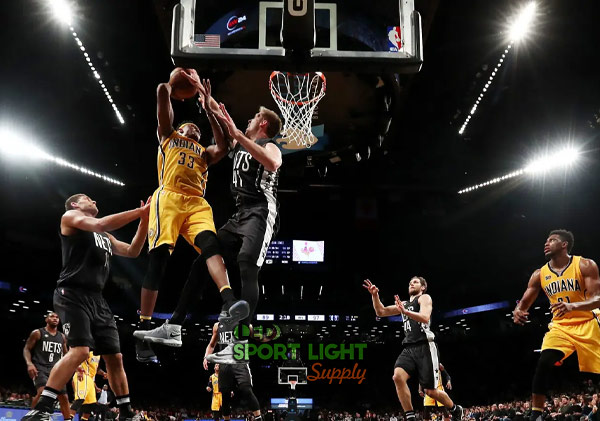
Flood Lights for Basketball Courts
Flood lights are a popular choice for illuminating basketball courts, both indoor and outdoor. These fixtures are known for their broad beam angles, typically ranging from 100 to 120 degrees, which makes them highly effective in covering large areas. The versatility of flood lights allows them to be used in various settings, making them a go-to solution for enhancing visibility on the playing surface.
In outdoor settings, flood lights are often employed to reduce obtrusive light and improve uniformity. While flood lights are generally short-range devices, careful installation is crucial to avoid glare and visual discomfort. Properly placed flood lights can deliver outstanding results, creating an even and bright environment for gameplay.
Though primarily used outdoors, flood lights can also be found in movable light towers for indoor settings, particularly as emergency or secondary lighting solutions.
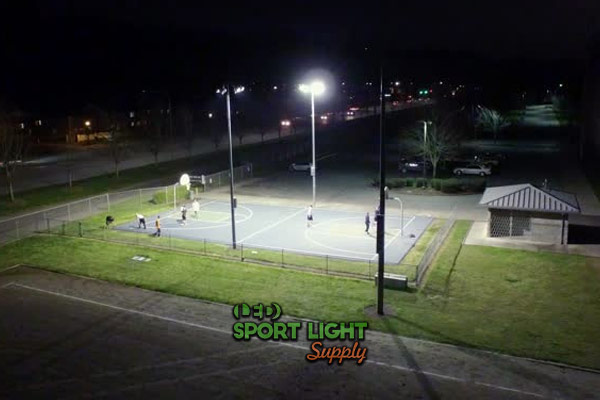
High Mast Lights
High mast lighting is particularly well-suited for outdoor basketball courts. These systems use tall poles equipped with multiple fixtures, providing a cost-effective and efficient lighting solution. High mast lights ensure ample visibility, reducing the risk of injuries and enhancing the accuracy of referee decisions during high-intensity games. Properly configured high mast lighting can make fouls and other critical game events more apparent.
Historically, high mast lighting systems employed halogen lights, high-pressure sodium (HPS) lamps, mercury-vapor bulbs, or metal halides. However, recent advancements have introduced LED technology, offering improved energy efficiency and longer lifespans. Modern high mast systems often feature LED fixtures with adaptive wireless controls, such as remote apps or Bluetooth, allowing for convenient adjustments and energy savings.
High mast lights generally last between 20 to 50 years, though the lifespan of the fixtures themselves varies. Many light poles are now designed to support solar lights as secondary or emergency lighting options.
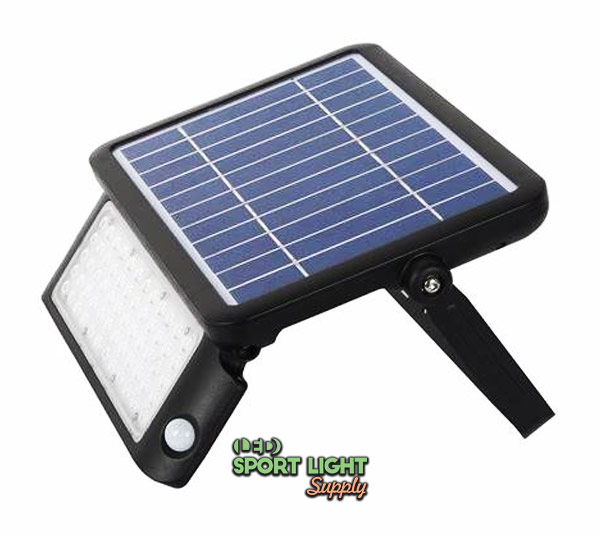
Solar Lights
Solar lights offer a sustainable lighting solution for outdoor basketball courts. These systems consist of LED fixtures, solar panels, and batteries. The solar panels, typically made of silicon, capture sunlight and convert it into electricity, which is stored in batteries for use during the evening or cloudy days.
While solar lights help reduce electricity costs, their effectiveness can be limited by weather conditions. Most solar fixtures require 8 to 10 hours of direct sunlight to recharge fully, which may not align with the schedule of many basketball games. Additionally, current solar technology may not provide sufficient brightness for official games, making them more suitable for training sessions or emergency lighting.
Despite these limitations, solar lights are a valuable addition to outdoor arenas, offering an eco-friendly option that becomes more competitive as technology advances.
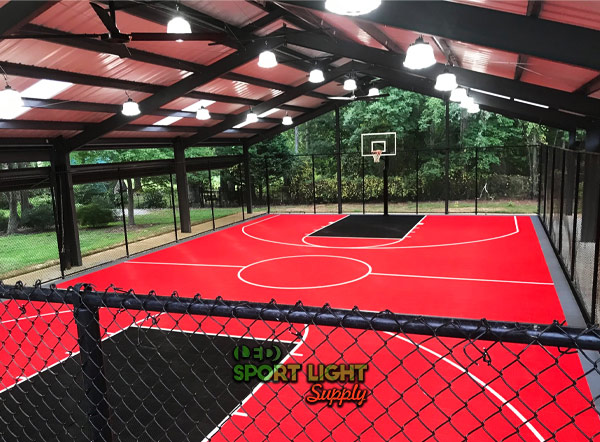
High Bay Lights
High bay lights have become a standard fixture in many indoor sports facilities, including basketball arenas. These UFO-shaped fixtures are suspended from the ceiling and provide illumination from above. High bay lights are favored for their ability to create optimal lighting designs and their efficiency in indoor settings.
When using high bay lights, it’s essential to consider factors such as wattage, brightness, and spacing to achieve the desired lighting effect. Modern LED high bay lights, often ranging from 150 to 200 watts, are cost-effective and provide excellent illumination. These lights may also include features like motion sensors, emergency drivers, and various mounting options, enhancing their functionality.
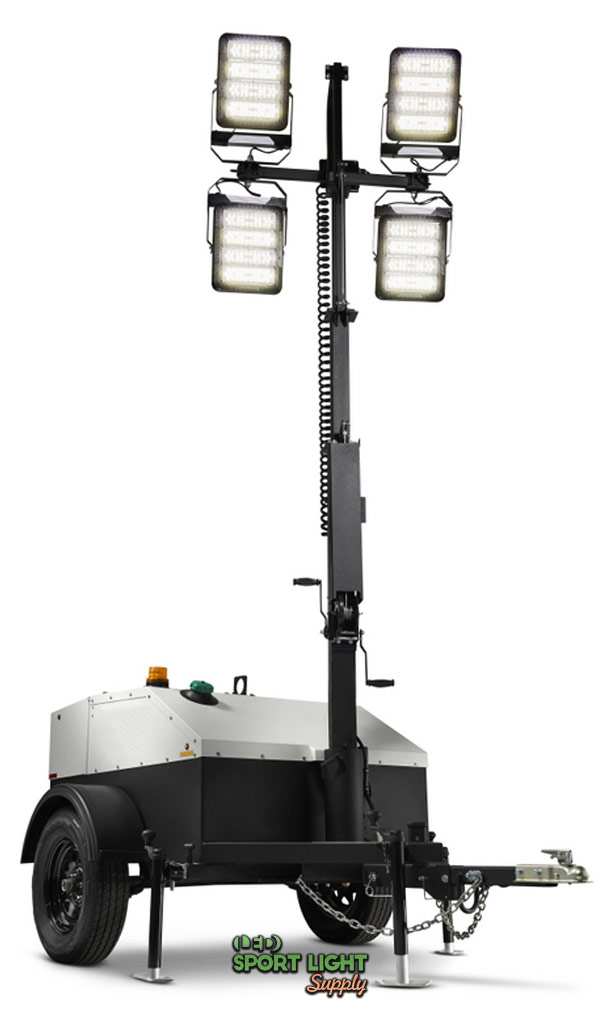
Portable Field Lights or Mobile Light Towers
For temporary outdoor lighting, portable field lights or mobile light towers offer a flexible solution. These systems typically consist of LED floodlights mounted on a retractable pole, supported by a portable generator and movable base. Portable light towers are ideal for scenarios where permanent high-mast lighting is impractical.
Equipped with 4 to 6 lights, portable towers can be directed to achieve better lighting uniformity across the court. They provide a versatile and convenient option for events or activities that require temporary illumination.
Basketball Court Lighting Design
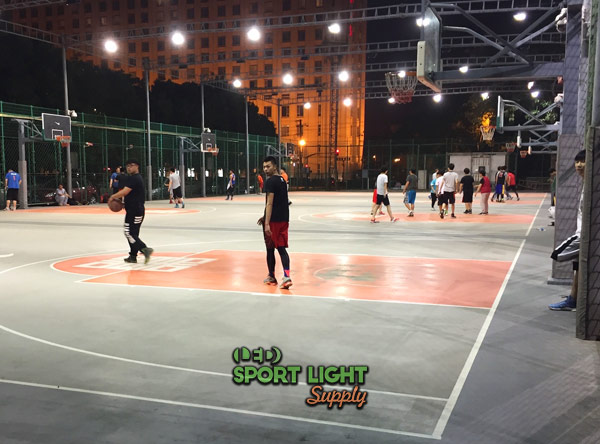
Lux and Footcandle Requirements
Lux measures the brightness that falls onto the basketball court, while footcandles, used in the imperial system, provide a comparable metric. The lux value is crucial for determining the appropriate lighting intensity for various levels of basketball competitions. For indoor basketball courts, different levels of play require specific lux measurements:
| Event Type | Lux Level | Footcandles |
|---|---|---|
| Top-class and International Competitions | 750 lux | 69.7 footcandles |
| National Basketball Games | 500 lux | 46.5 footcandles |
| Training and High School Competitions | 200 lux | 18.6 footcandles |
These standards ensure that the court is sufficiently illuminated to allow safe and effective play. For outdoor basketball courts, the lux requirements are generally lower:
| Event Type | Lux Level | Footcandles |
|---|---|---|
| International Events | 500 lux | 46.5 footcandles |
| National Competitions | 200 lux | 18.6 footcandles |
| Recreational Use and Training | 75 lux | 7 footcandles |
FIBA categorizes lighting standards into classes: Class I for international and televised events, Class II for regional and national competitions, and Class III for recreational and training use. Each class has distinct lux requirements to ensure proper lighting conditions.
Lighting Uniformity
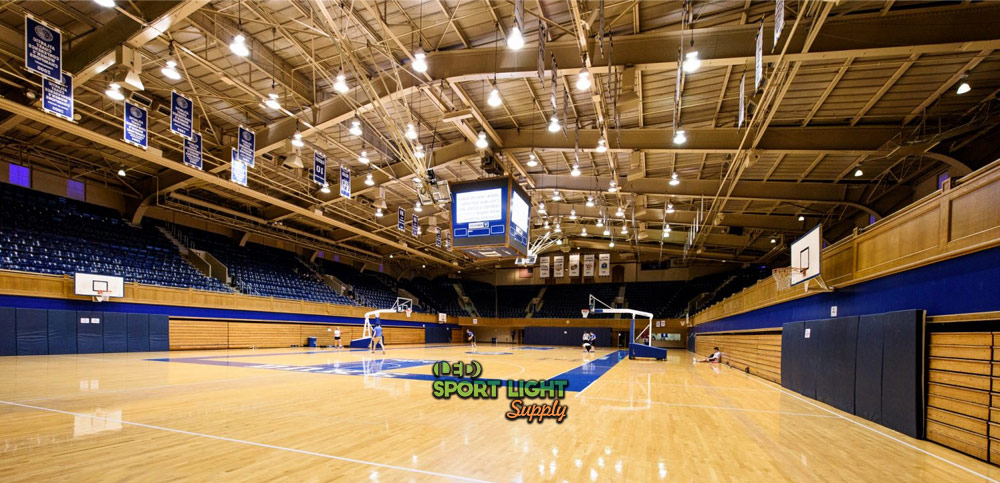
Lighting uniformity is essential for maintaining consistent visibility across the basketball court. Variations in light intensity can lead to distractions, impair player performance, and affect strategic gameplay. Uniform lighting ensures that all areas of the court are equally illuminated, reducing shadows and bright spots.
Uniformity is typically measured by dividing the court into a grid and taking lux readings from various points. An ideal lighting uniformity ratio for basketball games is 0.7, while for training sessions, a ratio of 0.5 is acceptable. Proper lighting design can be achieved using software like DIALux or by consulting a professional lighting designer.
Color Temperature
Color temperature describes the hue of light emitted by a fixture and is measured in Kelvin (K). This scale indicates the warmth or coolness of the light. For basketball courts, a color temperature in the range of 5,000 to 5,500 K is ideal, mimicking natural daylight and ensuring accurate color perception.
Different light sources emit varying color temperatures:
| Light Source | Color Temperature (Kelvin) | Description |
|---|---|---|
| Candlelight | Approximately 2,000 K | Yellowish light |
| Incandescent Lamp | Around 2,700-2,800 K | Yellowish-white light |
| Daylight | Approximately 5,000 K | Cool white light |
Modern LED lighting systems can offer adjustable color temperatures, providing flexibility to meet the needs of different sports and events.
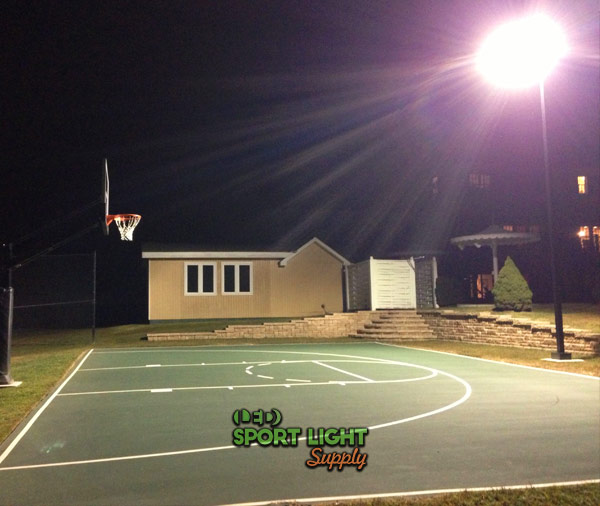
Glare (GR)
Glare can significantly impact visibility and comfort during basketball games. It occurs when intense light sources cause discomfort or reduce the ability to see clearly. To minimize glare, maintain a glare rating (GR) of less than 50. This helps to ensure that players, referees, and spectators have a clear view of the game, reducing the risk of injuries and improving overall game quality.
Reducing glare not only enhances visual comfort but also ensures accurate refereeing and prevents unnecessary tension on the court.
Color Rendering Index (CRI)
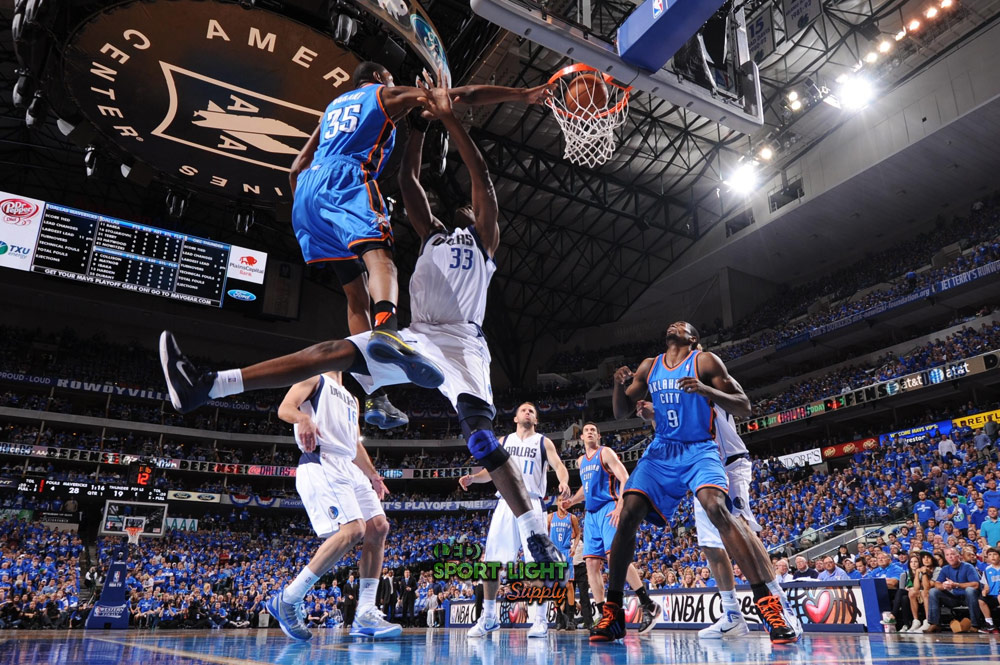
The Color Rendering Index (CRI) measures how accurately a light source renders colors compared to natural light. A high CRI value is crucial for ensuring that colors appear true to life, which is important for televised games and media coverage.
| Light Source/Activity | CRI (Color Rendering Index) | Description |
|---|---|---|
| Sunlight | Higher than 98 Ra | Full color spectrum |
| Televised Events (Class I and II) | At least 60 Ra | Good color rendering for broadcast |
| Recreational Activities (Class III) | 20 Ra | Basic color rendering |
Traditional light sources often fall short in CRI performance, making LED lights a preferable choice due to their high CRI ratings, often exceeding 90 Ra.
Flicker-Free Lighting for Broadcasting
Flicker-free lighting is essential for high-quality video broadcasting of basketball games. Flickering lights can cause banding and visual artifacts in video feeds, affecting the viewing experience. Modern LED lights have addressed this issue with flicker-free technology, which is crucial for major basketball leagues and events. Ensuring that your lighting system is flicker-free will enhance video quality and provide a better experience for viewers both in the stadium and at home.
Outdoor Basketball Court Lighting Layout
Number of Light Poles
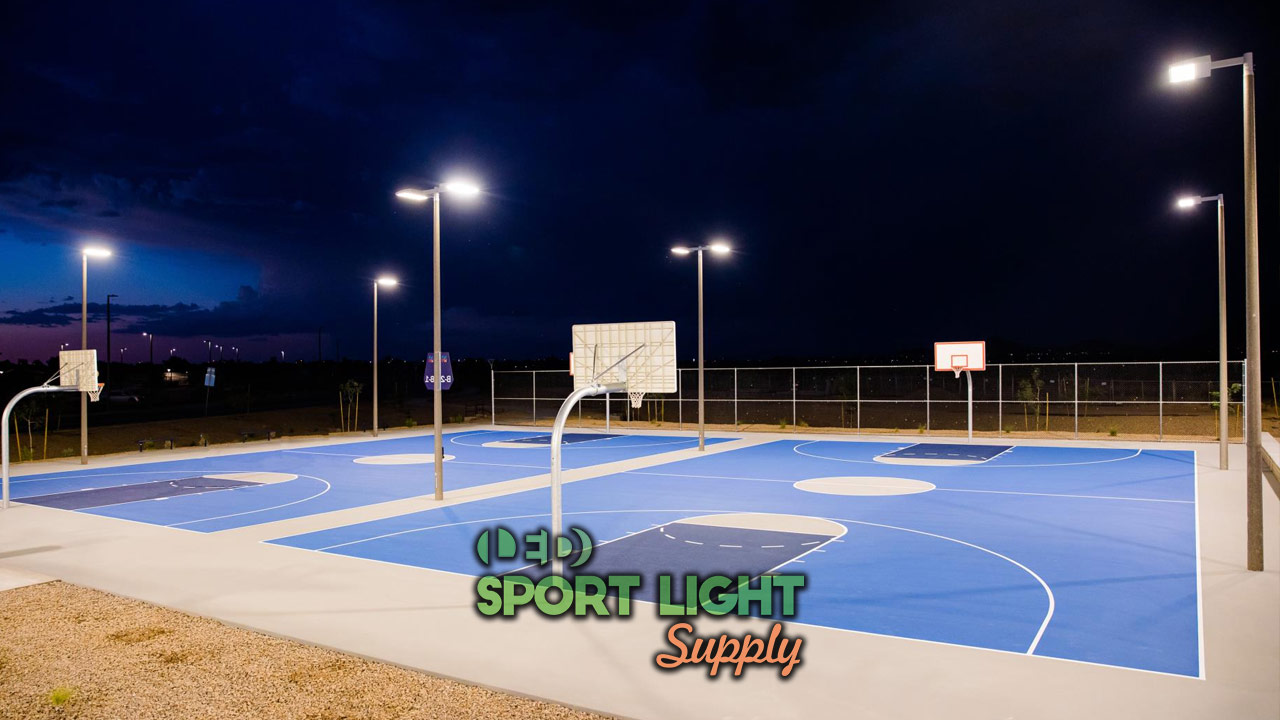
The number of light poles required for an outdoor basketball court significantly affects both the illumination quality and overall design. High mast lighting systems are commonly used, and the layout of these poles should be carefully considered:
| Layout Type | Description |
|---|---|
| Four-Pole Layout | Ideal for university sports facilities or multi-court setups. Each court may share poles with adjacent courts, such as using one pole on each side for three side-by-side basketball courts. This layout is space-saving and cost-effective. |
| Six-Pole Layout | Suited for larger courts or facilities needing more even illumination. Typically includes poles at the corners and additional poles along the sides to ensure comprehensive coverage. Larger or more complex installations might require up to six poles. |
The number of poles affects the uniformity of light distribution and can impact the overall cost of the lighting system.
Light Pole Height
The height of light poles plays a crucial role in achieving the desired illumination for outdoor basketball courts while balancing safety and cost considerations. Typically, light poles for these courts are recommended to be between 29.5 feet (10 meters) and 39.4 feet (12 meters) tall. This height range ensures adequate coverage of the playing area while minimizing potential safety hazards. Taller poles can cover a larger area with fewer fixtures, which might reduce the number of poles required. However, excessively tall poles can pose safety risks, such as difficulties in maintenance and increased susceptibility to wind damage. Consulting with lighting experts is essential to determine the optimal pole height, taking into account the specific dimensions and requirements of the court.
Position of Light Poles
The positioning of light poles significantly impacts the effectiveness of illumination on a basketball court.
In a four-pole layout, the poles are typically positioned near the corners of the court. This arrangement provides general illumination but may necessitate additional fixtures to achieve uniform lighting across the entire playing surface.
A six-pole layout offers greater flexibility, with poles often placed at the corners and additional ones along the sides of the court. This setup enhances coverage, particularly for larger courts, and can be tailored to focus on specific areas, addressing varied lighting needs more effectively.
For smaller or less formal settings, such as training or recreational courts, a two-pole layout might be used. This configuration usually involves placing poles on opposite sides of the court to provide basic illumination. However, it is generally inadequate for regular competitive play due to its limited coverage and intensity.
Beam Angle of LED Basketball Court Lights
The beam angle of LED lights is crucial for achieving proper illumination and minimizing glare on a basketball court. A broad beam angle, typically around 120 degrees, is recommended to ensure that the playing surface is covered effectively with even lighting. This wide angle helps to spread light across the court, preventing dark spots and providing uniform visibility.
Additionally, the tilt of LED flood lights is essential for reducing glare and enhancing player comfort. A maximum tilt angle of 70 degrees is generally used to direct light appropriately, ensuring that it falls where needed while avoiding obtrusive lighting.
Properly managing beam angle and fixture tilt also helps to minimize light pollution and sky glow. By carefully designing the lighting setup and considering the boundaries of adjacent areas, it is possible to prevent unwanted light spill in densely populated regions, contributing to a more efficient and environmentally friendly lighting solution.
Indoor Basketball Court Lighting Layout
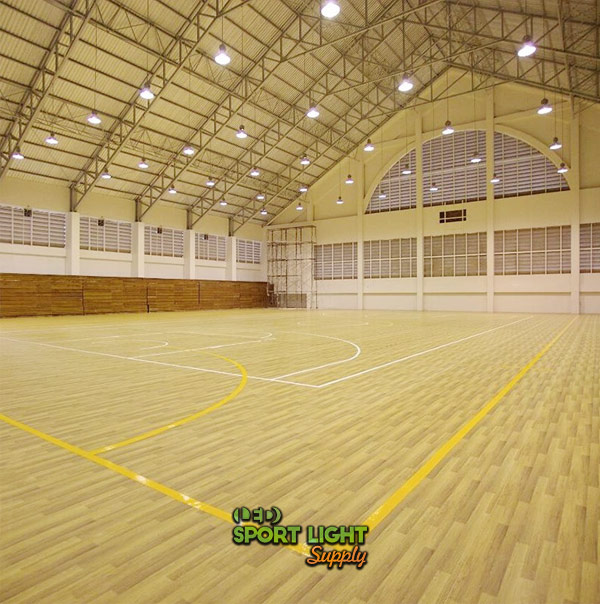
Direct Lighting Layout
Direct lighting provides focused illumination by directing light straight onto the basketball court, ensuring that the majority of the light falls directly on the playing surface. This approach optimizes visibility for both players and spectators. High bay lights are typically used for direct lighting in indoor basketball courts. These fixtures deliver intense illumination directly onto the court, resulting in bright and clear visibility. However, due to the concentrated nature of the light, shadows can be created. To address this issue and achieve uniform lighting, additional light sources or fixtures may be necessary. This helps distribute light evenly across the court, reducing dark spots and enhancing overall visibility. Direct lighting is particularly effective for general use and competitive play, making it the preferred choice for most sports facilities due to its clear and bright illumination.
Indirect Lighting Layout
Indirect lighting involves directing light toward the ceiling or walls, where it then reflects onto the basketball court. This method produces a softer, more diffused light, which enhances the ambiance of the space. In this setup, 90% to 100% of the light is directed upwards, bouncing off surfaces to evenly illuminate the court. This approach helps to eliminate harsh shadows and provides consistent lighting from all directions. To compensate for the light loss associated with indirect lighting, more powerful LED lights are required to ensure that the court remains adequately illuminated. Indirect lighting is often used in high-end basketball arenas and stadiums to create a welcoming and aesthetically pleasing environment. A hybrid approach, combining both direct and indirect lighting, can also be employed to provide focused illumination where needed while maintaining an overall ambient light level.
Spacing Between High Bay Lights
The proper spacing of high bay lights is crucial for achieving optimal lighting results and ensuring even coverage across the basketball court. A general guideline suggests spacing the lights at a distance equal to half the ceiling height. For example, if the ceiling height is 30 feet (9 meters), the lights should be spaced approximately 15 feet (4.5 meters) apart. Additionally, it is important to position the lights at least three feet away from any walls to avoid creating unwanted shadows and to maintain proper ceiling perception. For precise spacing and layout, consulting a professional lighting designer is recommended, as they can provide tailored solutions based on the specific dimensions and requirements of the basketball court. Implementing a smart light control system can also enhance flexibility, allowing for adjustments based on usage, such as during local games or training sessions, ensuring efficient lighting management.
Number of High Bay Lights
Determining the correct number of high bay lights is essential for meeting the required lux levels and ensuring effective illumination. Specialized software like DIALux can be used to estimate the number of fixtures needed, helping to design a lighting layout that meets the necessary lux requirements while considering cost efficiency.To determine the total lumens required for your basketball court lighting, you need to multiply the lux requirement by the size of the basketball court in square meters and then increase this number by 20% to account for light loss. After finding the total lumens needed, divide this figure by the lumen output of each LED fixture to calculate the number of lights required.
Basketball Court Lighting Q&A
How much does it cost to light a backyard basketball court?
The cost of lighting a backyard basketball court varies based on location and usage. For a backyard court with a lighting requirement of less than 200 lux, you would typically need at least two 500W LED floodlights, each providing around 50,000 lumens. In residential settings, the electricity cost for running these lights is about $0.11 per hour, while commercial setups might see costs as low as $0.06 per hour. The fixtures themselves generally cost between $100 and $200 each. Keep in mind that the exact costs can fluctuate based on local electricity rates and installation specifics.
What type of lamp or lamps are recommended for a basketball court?
LED floodlights and spotlights are highly recommended for basketball courts. Unlike traditional lighting, where higher voltage meant brighter light, LEDs offer superior brightness with lower wattage. They are more cost-efficient and have a longer lifespan, lasting over ten times longer than conventional light sources. LED lights also overcome design limitations like fixed color temperatures and overheating issues. For outdoor courts, high mast lighting with LED fixtures is a popular choice, while indoor courts benefit from LED high bay lights for cost-effective and efficient illumination.
How to design indoor basketball court lighting?
Designing indoor basketball court lighting involves setting the desired illumination standard and considering your goals and budget. Start by gathering as much information as possible and then consult a professional for a photometric analysis if needed. For venues hosting major events like FIBA or national basketball league games, it’s crucial to hire a lighting designer to ensure compliance with broadcasting and association standards. Unlike outdoor courts, indoor arenas rely on artificial lighting alone, making color rendering and uniformity essential aspects of the design.
Conclusion
Designing effective basketball court lighting requires a blend of technical expertise and practical considerations. From the initial planning using specialized software to the careful selection and placement of fixtures, every aspect plays a role in achieving optimal illumination. Whether for indoor or outdoor courts, the goal is to create a well-lit environment that enhances both player performance and spectator experience while minimizing glare and light pollution. By understanding and applying these principles, you can ensure that the lighting system not only meets the required standards but also contributes to a vibrant and engaging game environment.
